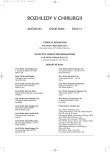Delayed Laparotomies in Blunt Injuries of the Abdomen: Incidence Rates, Causes, Mortality Rates and Hospitalization Times in a Group of 139 Operated Patients. A Retrospective Study
Opožděné laparotomie u tupých úrazů břicha: výskyt, příčiny, mortalita a doba hospitalizace v souboru 139 operovaných pacientů. Retrospektivní studie
Úvod:
Postup u tupých úrazů břicha je v současnosti ovlivňován zobrazovacími vyšetřeními a úspěchy konzervativní léčby. Nedochází ale k nárůstu opožděných operací a komplikací?
Pacienti a metoda:
Autoři provedli retrospektivní analýzu souboru 139 operovaných pacientů. Při jejich příjmu bylo postupováno podle jednotného algoritmu. U operovaných déle než 24 hodin po přijetí (GROUP A) byla sledována: příčina opoždění, mortalita a délka hospitalizace na intenzivním lůžku (ICU). Parametry byly porovnány s odpovídající skupinou pacientů operovaných do 4 hodin (GROUP B).
Výsledky:
GROUP A zahrnovala 17 (12,23 %) pacientů. Medián odkladu byl 4 dny (1–48). Diagnostika selhala v 9 (52,94 %), konzervativní léčba v 8 (47,06 %) případech. Mortalita byla 29,41 %. GROUP B měla signifikantně vyšší pravděpodobnost přežití (p-value 0,0445). V délce hospitalizace na ICU nebyl statisticky rozdíl.
Závěr:
U tupých úrazů břicha nelze plně spoléhat na závěry zobrazovacích vyšetření včetně CT, zejména u poranění střeva a bránice. Při indikaci konzervativní léčby je nutno monitorovat pacienta a neztratit aktivní chirurgický přístup.
Klíčová slova:
tupý úraz břicha – algoritmus postupu u poranění břicha
Authors:
P. Chmátal; P. Kupka; V. Vlasák; H. Pavlovičová *
Authors‘ workplace:
Chirurgické oddělení, Ústřední vojenská nemocnice Praha
; Katedra aplikované matematiky, Přírodovědecká fakulta Univerzity Karlovy Praha
*
Published in:
Rozhl. Chir., 2006, roč. 85, č. 2, s. 59-63.
Category:
Monothematic special - Original
Overview
Introduction:
Employment of visualizing methods and achievements of conservative treatment methods have a major influence on the management of blunt abdominal injuries. The aim of the study is to assess incidence rates of, possibly, delayed surgeries and complications.
Patients and Methods:
The authors conducted a retrospective analysis in a group of 139 operated patients. A common algorithm was followed on their admission. The following parameters were assessed in patients operated later than 24 hours following their admission (GROUP A): a cause of the delay, a mortality rate and duration of their intensive care unit (ICU) hospitalization. The parameters were compared to those of a corresponding patient group operated no later than 4 hours after their admission (GROUP B).
Results:
The GROUP A included 17 (12.23%) patients. The delay median was 4 days (1–48). The diagnostics failed in 9 (52.94%), the conservative care failed in 8 (47.06%) subjects. The mortality rate was 29.41%. The GROUP B had significantly higher survival rates (p-value 0.0445). There was no statistically significant difference in the parameters of the ICU hospitalization duration.
Conclusion:
Diagnostic conclusions of visualizing methods, including CT scans, cannot be fully relied on in blunt abdominal injuries, mainly in cases of intestinal and diaphragmatic injuries. When a conservative treatment is indicated, the patient has to be closely monitored while sustaining an active surgical approach.
Key words:
blunt abdominal injury – algorithm of the abdominal injuries management
Labels
Surgery Orthopaedics Trauma surgeryArticle was published in
Perspectives in Surgery

2006 Issue 2
- Metamizole vs. Tramadol in Postoperative Analgesia
- Metamizole at a Glance and in Practice – Effective Non-Opioid Analgesic for All Ages
- Metamizole in perioperative treatment in children under 14 years – results of a questionnaire survey from practice
Most read in this issue
- The First Case of Management of the Rectovaginal Fistule Using Transanal Endocsopic Microsurgery
- Internal Hernias – Uncommon Causes of the Status Ileosus
- An Axillary Metastasis as the First Sign of the Breast Carcinoma – A Case Review
- Lung Resection for a Non-small Cell Carcinoma (Stage IV) with a Permanent Intracavitary Brachytherapy 125I
